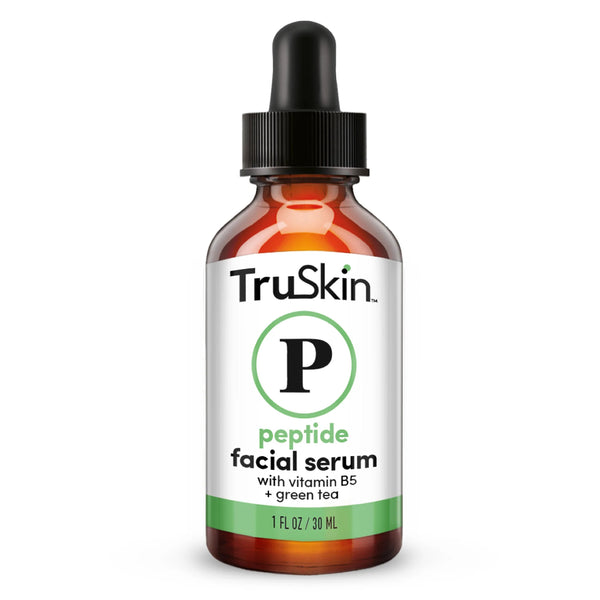
Can Peptides Help Your Skin Deal With The Visible Signs Of Aging?
Here’s what we know about the wonderful world of peptides. Heads up: fine lines and rough texture be afraid, be very afraid.
Just when you thought you’d gotten your head around the retinols and hyaluronic acids of the skincare world, another ingredient starts to make headlines and the confusion hits all over again. Take peptides, for example, which is not just one single entity but a whole bunch of ingredients with crazy long names to figure out. Mind-blowing stuff, right? Weeeeell, not so much. Sure, there are tons of peptides used in skincare and yes, they all have pretty science-heavy names like Palmitoyl Tripeptide-1 and Palmitoyl Tetrapeptide-7, but you really only need to know a few basic things in order to get great results.
First, what they are. And second, what they do.
So, here we go…
What Exactly Are Peptides?
OK, time to get your science caps on. Peptides are chemical compounds made up of short chains of amino acids. Amino acids are also the building blocks of protein in your skin. However, the difference is that proteins like collagen, elastin and keratin are large molecules, made up of many, many amino acids, whereas peptides are shorter chains of between two and around 50 amino acids. What does all this mean? Well, studies show that because of their similar yet smaller molecular makeup, peptides are able to penetrate the skin more easily where they signal your cells to produce more of all those fabulous proteins.
How Do Peptides Benefit Your Skin?
Collagen, elastin and keratin are the absolute foundation of healthy skin, giving it valuable support, structure and strength. With age (as well as environmental bad boys like pollution and the sun), your skin produces less and less of these essential proteins which is when all those so-called imperfections you can’t bear start to rear their heads. Pesky lines around your mouth… annoying crow’s feet… a bit of sagging skin here and there… you know the drill. Frankly, other people barely notice these 'flaws' you can't stand, so they're not THAT big of a deal, but that being said, there’s nothing wrong with wanting to care for your skin in order to hold onto your best complexion for as long as possible. And we get that.
It figures, then, that anything you can do to boost collagen, elastin and keratin production (aka apply peptides!) is a major plus for the look and feel of your skin. Think less pronounced lines; firmer, lifted skin and tighter-looking pores. Some peptides even have anti-inflammatory benefits which is great if you suffer with irritation, redness and sensitivities every now and again.
The fact is there's very little to disprove the amazing anti-aging benefits of applying peptides to your skin.
The TruSkin Golden Rules For Peptides In Skincare
1. Peptides Work Best As A Team
Most skincare brands combine a carefully curated cocktail of two or more peptides to offer the best, most complete anti-aging deal for your skincare routine. So, look for multiple ingredients that end with 'peptide' and/or begin with 'palmitoyl’ for a great, all-round product. Also, stick with formulations that are packaged in dark, airtight containers. Light and air can degrade certain peptides which makes them less effective.
Our new Peptide Facial Serum checks all these boxes by combining palmitoyl tripeptide-1, palmitoyl tetrapeptide-7 and palmitoyl tripeptide-5 which are well-known in the biz for their collagen and elastin-boosting skills. Together with a blend of ten silk-derived amino acids this skin-loving serum is the ideal way to help your complexion snap back to life.
2. Leave-On Peptides Are What It’s All About
Experts agree that to gain the best results from peptides you should go for products that get left on your skin, so they have time to penetrate the surface and go about their age-busting business. This means serums, toners and moisturizers are your best bet rather than cleansers or face masks.
As well as our awesome new Peptide Facial Serum, Ocean Minerals Daily Face Super Toner is a great shout here. It contains palmitoyl oligopeptide and palmitoyl tetrapeptide-7 to support collagen, elastin and hyaluronic acid production and help kickstart more youthful-looking skin.
3. Peptides Are Awesome for the Skin Around Your Eyes
Certain active ingredients like retinoids can be a little too powerful for the delicate skin around your eyes. Not so with peptides. Much safer and kinder to your skin, peptides are the ideal choice for dealing with aging eye concerns like crow’s feet, crinkling and crepey skin. This is why we packed a whole bunch of peptides into both of our eye treatments. Peptide Eye Gel, for example, is chock-full of them (the clue is in the name, after all!) and contains palmitoyl tripeptides-1 and -5, plus the mighty matrixyl 3000.
Matrixyl 3000 is a combination of several peptides and has been proven to boost collagen synthesis and help repair damaged, aging skin. In fact, one study showed that Matrixyl can almost double the amount of collagen your skin. We’re so on board with that.
4. Peptides Are Safe For Most Skin Types, But…
Patch testing is still important. Your body makes amino acids and proteins naturally, making peptides very well tolerated by most skin types. However, skin irritation can still occur if you’re super sensitive or if there are other active ingredients in the same product.
To perform a patch test, apply a small dot of product to a discreet patch of your skin. Maybe behind your eyes, inside your elbow or on your wrist. Then leave it for 48 hours to check for irritation. The chances are, you’ll be totally fine but any unlikely reaction that’s painful, uncomfortable, stinging or itchy is a major red flag and a sign that you should discontinue use.
















